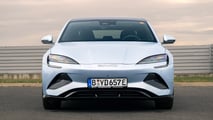
Whenever I attend an international launch for a new Chinese car, I can’t help overhearing what other English-speaking journalists are talking about. Some are still making jokes about the Chinese car industry, like it’s still 2010, and Western automakers still dominate technology and sales.
However, it’s 2025, and China’s largest carmaker, BYD, sells more plug-in cars than anyone else on Earth and boasts some of the fastest-charging and most advanced electric vehicles in the world.
It seems crazy to me how some journalists are still making jokes about the fact that BYD is Chinese, suggesting that it can never be as good as the Western car brands that we all grew up looking up to (at least here in Europe). BYD is a global Goliath with over 100,000 engineers on its payroll, giving it the largest research and development workforce of any automaker in the world. It shows.
If you haven’t been paying attention to the rise of BYD, it’s not too late. If you live in Europe, you can go test drive one of its cars to rid yourself of your bias.
I will admit that, like any European car journalist, I once looked down on Chinese cars. Many of my American colleagues did, too. However, as I’ve had the chance to drive more of them in the last few years, I realized it would be foolish of me to keep holding on to that bias. One of the first that blew me away was the Zeekr 7X, which I had the opportunity to drive at its European launch in Portugal.
The 7X is about as good as midsize SUVs get these days, regardless of what powers them. It felt like a Volvo, but better. I couldn’t help but notice that everything felt luxurious, well-engineered and smartly thought out. BMW offers powered doors in its latest 7 Series and i7, but they are significantly inferior to the ones on the 7X, which open quicker, are far less temperamental, and don’t rely on ugly exposed parking sensors to detect potential obstacles. A Chinese carmaker doing something much better than BMW? That couldn't be right, I thought at the time.
But it is just one example. Then I drove my first BYD, which was a Dolphin Surf, the city car that’s also known as the Seagull in some markets. It not only looks like a mini Lamborghini Urus (because it happens to be designed under the guidance of the same person), but it drives with surprising pep and verve, and it’s very affordable when you factor in how much equipment you get.
The Surf could become BYD’s biggest hit in Europe, where people really like this kind of tiny city-focused subcompact EV. But it's early to say—the segment is getting increasingly crowded with very good rivals like the Hyundai Inster, and BYD still has to build up its brand here.
This brings me to the BYD Seal, a car I was in for over 600 miles during one day of an EV road trip, from the north of Italy through Hungary (where BYD is building a massive production facility). That’s a lot of seat time (mostly spent behind the wheel), and it was enough to rid me of any trace of bias I may have still held against Chinese cars for good. Spending this much time in a car, you start to notice things.
As a driver, I liked how planted the car felt on the road. The suspension is firm and well-controlled, a similar setup to what you would expect from a Western car with 523 horsepower and 501 lb-ft of torque. The performance is also great. In a straight line, it feels as quick as a BMW i4 M50, although it doesn’t quite deliver the same punch in the stomach that you get from the lighter Tesla Model 3 Performance, whose much lower weight makes it feel noticeably quicker.

What I’m trying to say is that the Seal feels in no way inferior to any Western car in the same class, with the same specs. When it comes to the fit and finish quality, I would say it’s even better.
I drove the Seal in parallel with an Audi A6 e-tron Quattro, which is around twice as expensive, yet is less powerful and it doesn’t feel significantly better inside. Comparing it to the electric A6 really put the Seal into perspective and it highlighted its strengths. It’s not a cheap car, but it represents remarkable value.
The Seal entered the European market in late 2023, and it’s one of the pillars for the Chinese manufacturer's continued growth on the continent. It helped BYD outsell Tesla in Europe this August, bolstering a lineup that is now eight-strong in some countries. It’s not just private owners who picked a Seal over all of its competitors, but also ride-hailing drivers. My first time as a passenger in a BYD was when I ordered an Uber in Stuttgart over a year ago, and I got a Seal sedan. It's a logical choice.
As it pulled up, I also couldn’t help but notice that it looked great, with the proportions of a typical European sports sedan—it did not look out of place in the posh area of Stuttgart where I got picked up. At the time, I still didn’t believe the brand would make as big an impact as it has, although I couldn’t help but notice how nice it felt to ride in the back of a Seal.
Gallery: 2025 BYD Seal 3.8S







Now that I’ve driven one, I have a much more nuanced view of the car, which is among the electric sedans I’d most consider buying today. It’s not perfect, but it’s way better than you think if all you know about Chinese cars is dictated by old preconceptions. Sure, it could charge quicker and have a more consistent charging curve, but BYDs sold in China are among the quickest-charging EVs in the world—we know, as InsideEVs editor-in-chief Patrick George went to China to witness it—so the manufacturer is bound to bring this to Europe, too.
“Disruption” is a word you hear thrown around a lot in the Western media, often when referring to a non-Western product coming in and upsetting the local balance of power. BYD is definitely a disruptor and it is no longer just a novelty or a curiosity. BYD's year-over-year sales for the first nine months of 2025 in Europe surged over 300% with over 120,000 cars (all of which are either PHEVs or full EVs) delivered.
If you think Chinese cars still can’t match what Europe is making, driving something like a BYD Seal is going to rock your world. We can’t pretend that cars from BYD, Geely, Nio or Xpeng are any less compelling than their European or American competitors.
Western automakers need to stop sneering and start learning and adapting to a new global automotive industry reality: They have some catching up to do. And the Western journalists who don't get that need to pay closer attention, too.








